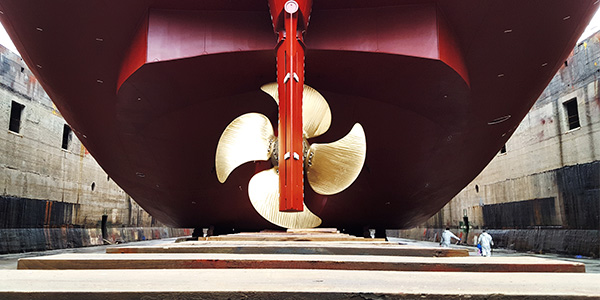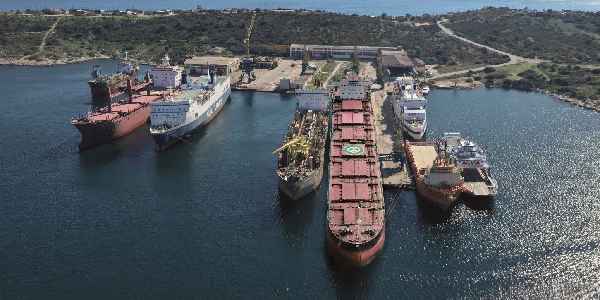The propeller of a vessel is an integral part, whose efficiency impacts the ship’s speed, meeting deadlines and staying on schedule. During the ship’s lifetime, propellers can suffer from various problems, be it due to poor design or excessive use, which in the long run can have a negative impact on marine operations. Therefore, it’s crucial to understand how to spot common issues with ship propellers in order to take immediate actions to fix these and stay ahead of the game.
Maintaining your ship’s propeller is essential to maintain operation at full potential and extend the lifespan of the vessel along with its internal components.
Although routine maintenance may keep your ship’s propeller in check, you may still experience several issues. For instance, a propellers’ condition depends on factors like waters the vessel sails in, your sailing expertise, how often you use your ship and others. There’s a good probability that you will be able to save your ship’s propellers if you can recognize the necessary repair needed before it is too late.
Regardless of how well you maintain your ship propeller, below are a few common problems you may encounter and need to understand in order to resolve them:
Damaged Blades
It’s easy to notice damages on blades, however, not always easy to fix. Possibly, your ship’s propeller blades may have experienced warping or denting when not operating smoothly. For instance, if your propeller blades hit sand bars, come too close to rocks, or bottom out, it can easily be damaged.
For this reason, you should check if any blades are crooked, missing parts, or at an odd angle. Blades must be changed or fixed right away if they appear damaged as this can reduce your ship’s fuel mileage, can cause vibrations or limit the engine’s RPM or put extra pressure on various other engine components. There is a chance that a propeller if not fixed may damage the engine leading to additional costly repairs. However, with routine inspection, you may identify such damages straight away and repair them without causing any additional issues.
Small Cracks
A small crack in your propeller can rapidly grow and eventually turn into a much bigger issue. Deformations caused by collisions with hard objects or normal wear can act as stress risers, thus, making the blade more vulnerable to severe cracks when in operation. Your propeller may become inoperable due to a hairline crack, requiring an expensive repair.
Naturally, the sooner you detect a crack, the easier it is to repair. In case a propeller is stainless steel, it is frequently heat-treated to increase strength and durability. You might be able to grind the blades to smooth out any minor dents or scratches. This prevents them from deteriorating with use. However, you should be cautious not to grind them down too much as it could lead to an imbalance of the blades and affect your ship’s fuel efficiency.
Wear and Tear
Your propeller’s blades could be uniformly worn out to the point where they need to be replaced even though they all appear to be the same. Pointed or sharpened blades on the leading edges are a few signs of even wear. You can take measurements of the propeller blades and compare them to the diameter of the original design if you think they are wearing down too quickly.
When propeller material degrades, the shorter diameter might result in greater RPM, decreased efficiency, or even engine damage. It is suggested that you take your propeller to a repair shop if you notice any significant wear, as they should be able to rebuild the blades back to the original measurements if there is sufficient base material remaining. However, you may require a replacement propeller if there is excessive wear, especially if it is an aluminum model.
Corrosion
It is common for ships to set sail in seawater, which can corrode propellers and make the metal appear uneven. It causes some of the alloy to dissipate from the metal. The saltwater drives out the less noble metal from the alloy material by acting as a transfer electrolyte. If your propeller’s anodic shields are improperly bonded, rust may effectively create holes in your blades, making them worthless.
In addition to stainless steel propellers, bronze and aluminum alloy propellers are also more susceptible to corrosion. The main distinction is that, if detected promptly, stainless steel blades might still be usable. Typically, a new propeller is needed when there is significant pitting.
When it comes to ship propeller repairs or replacements, it’s important to work with a company you know you can rely on. Kynosoura Dockyard, one of the best marine service providers, meet all your shipbuilding needs. Every ship we construct or repair is built with high-quality materials, meticulous techniques, and a keen attention to detail.
Discover more about our services, from construction tasks, keeping vessels clean to protecting surfaces from corrosion. Our expert marine engineers, handpicked for their best knowledge on vessel construction, assessment, and many other ship technical aspects, are here to help you with the process.
At Kynosoura Dockyard, we provide shipbuilding and repair services in Salamis, Greece for over 50 years. We work to provide you with high quality and safety standards that are created to meet the demands of the shipping industry on the most cost-effective basis through our shipyard and large pool of experienced labor strategically located in the heart of the Mediterranean.




